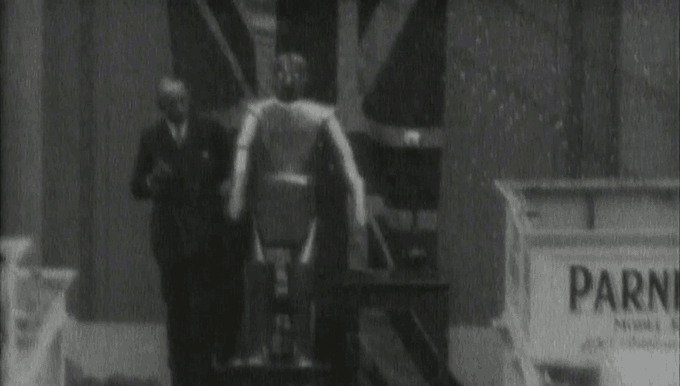Help London’s Science Museum Bring Britain’s First Robot Back to Life
Eric impressed crowds in the 1920’s by standing up, bowing, and shooting sparks from his teeth
:focal(404x278:405x279)/https://tf-cmsv2-smithsonianmag-media.s3.amazonaws.com/filer/1b/41/1b41002a-ad4e-4b91-a36a-2d8062cc0d32/eric_the_robot.jpg)
We think we’re so modern because our robots can break dance, make cars, and run like cheetahs. But not even a robot bartender can shock our senses like Eric, Britain’s first robot, did when he first stood up and gave a four-minute introductory speech while sparks shot out of his mouth at the Exhibition of the Society of Model Engineers in London in September 1928.
According to Sarah Knapton at The Telegraph, the bot was a sensation, and impressed the crowd by bowing, looking right and left, and making arm gestures. The 100-pound automaton was covered in aluminum, had light bulbs for eyes, and 35,000 volts of electricity caused him to spit blue sparks. The initials R.U.R. (Rossums Universal Robots) were imprinted on his chest, an acknowledgement of a play by the same name by Czech dramatist Karel Čapek, which introduced the word “robot” to English in 1921 (no word on why he’s named Eric, though).
“Eric was everything you imagined a robot to be. He was a talking, moving man of steel,” explains Ben Russell, curator at the Science Museum in London. “But what is most incredible is he was one of the world’s first robots and the first one built in the UK.”
That’s the reason Russell and the Science Museum have launched a Kickstarter campaign to raise about $50,000 and bring Eric back to life to star in the museum’s "Robots" exhibition slated to open in February 2017. The display will include 100 automatons from throughout history, including a 16th century "mechancial monk."

After that initial appearance at the Royal Horticultural Hall in 1928, Eric, built by WWI veteran William Richards and aircraft engineer Alan Reffell, went on a world tour with his inventors, standing, bowing and repeating canned phrases for technophiles in New York and across Europe. He made a splash in the media, and according to Russell, the New York press dubbed him “the almost perfect man.” But after all the accolades, Eric’s trail vanishes.
According to Knapton, the museum is using the original drawings for Eric and images from the Illustrated London News to remake him. While Eric’s exterior is well documented, the curators don’t really know what made him tick. That’s why Russell has brought aboard sculptor and robotocist Giles Walker to rebuild Eric and give him 21st Century guts over the next three months.
Once Eric is complete, he will be on permanent display at London's Science Museum, though Russell says he may go on another world tour before settling down for good.